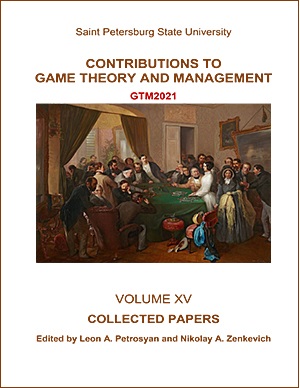Two-stage Minimum Cost Spanning Tree Game under Fuzzy Optimistic Coalition
DOI:
https://doi.org/10.21638/11701/spbu31.2022.07Abstract
Keywords:
optimistic game, fuzzy game, Choquet integral, spanning tree game
Downloads
Download data is not yet available.
References
Aubin, J. (1981). Cooperative fuzzy games. Mathematics of Operations Research, 6(1), 1–13
Bergantios, G. and Vidal-Puga, J. J. (2007). The optimistic TU game in minimum cost spanning tree problems. International Journal of Game Theory, 36(2), 223–239
Bird, C. G. (1976). On cost allocation for a spanning tree: A game theoretic approach. Networks 6(4), 335–350
Butnariu, D. (1980). Stability and Shapley value for an n-person fuzzy game. Fuzzy Sets and Systems, 4(1), 63–72
Cheng, M. and Li, Y. (2021). New Characteristic Function for two-stage Games with Spanning Tree. Contributions to Game Theory and Management, 14, 59–71
Dianqing, Y. and Dengfeng, L. (2021). Fuzzy coalition cooperative game method. In: Hao, J. (ed.). Fuzzy cooperative game method and its application, Vol. 2021.10, pp. 27-59. Beijing: Science Press (in Chinese)
Dutta, B. and Kar, A. (2004). Cost monotonicity, consistency and minimum cost spanning tree games. Games and Economic Behavior, 48, 223–248
Kruskal, J. B. (1956). On the Shortest Spanning Subtree of a Graph and the Traveling Salesman Problem. Proceedings of the American Mathematical Society, 7, 48–50
Petrosyan, L. A. and Sedakov, A. A. (2014). Two-Stage Network Games. Vestnik of Saint Petersburg University. Series 10. Applied Mathematics.Computer Science. Control Processes, 4, 72–81
Prim, R. C. (1957). Shortest connection networks and some generalizations. The Bell System Technical Journal, 36(6), 1389–1401
Shaohong, Y. and Macro, W. (2017).Fuzzy set. In: Haiyan, Y. (ed.). Fundamentals and Applications of Fuzzy Mathematics, Vol. 2017.12, pp. 8-41. Beijing: Chemical Industry Press (in Chinese)
Tsurumi, M. Tanino, T. and Inuiguchi, M (2001). Theory and methodology: a Shapley function on a class of cooperative fuzzy games. European Journal of Operational Research, 129(3), 596–618
Yin, L. (2016). The dynamic Shapley Value in the game with spanning tree. In: 2016 International Conference Stability and Oscillations of Nonlinear Control Systems (Pyatnitskiy's Conference). pp.1–4. IEEE
Downloads
Published
2023-01-26
How to Cite
Guo, Z., Wang, D., Chen, M., & Li, Y. (2023). Two-stage Minimum Cost Spanning Tree Game under Fuzzy Optimistic Coalition. Contributions to Game Theory and Management, 15, 81–95. https://doi.org/10.21638/11701/spbu31.2022.07
Issue
Section
Articles
License
Articles of "Contributions to Game Theory and Management" are open access distributed under the terms of the License Agreement with Saint Petersburg State University, which permits to the authors unrestricted distribution and self-archiving free of charge.




